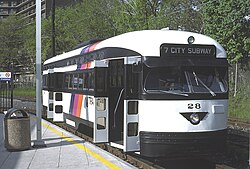Branch Brook Park | |||||||||||
|---|---|---|---|---|---|---|---|---|---|---|---|
 Branch Brook Park station in April 2015 from the ramp to Heller Parkway | |||||||||||
| General information | |||||||||||
| Location | North 5th Street & Anthony Street Newark, New Jersey | ||||||||||
| Coordinates | 40°46′47″N74°10′29″W / 40.7797°N 74.1748°W | ||||||||||
| Owned by | New Jersey Transit | ||||||||||
| Platforms | 1 island platform, 1 side platform | ||||||||||
| Tracks | 2 | ||||||||||
| Bus stands | 5 | ||||||||||
| Connections | |||||||||||
| Construction | |||||||||||
| Structure type | Below grade | ||||||||||
| Parking | 112 spaces [1] | ||||||||||
| Bicycle facilities | Yes | ||||||||||
| Accessible | Yes | ||||||||||
| Other information | |||||||||||
| Station code | 30762 [2] | ||||||||||
| History | |||||||||||
| Opened | May 26, 1935 | ||||||||||
| Rebuilt | 1940, 1953, 2001 | ||||||||||
| Previous names | Franklin Avenue, Heller Parkway | ||||||||||
| Services | |||||||||||
| |||||||||||
| |||||||||||
Branch Brook Park station is a light rail station in the Forest Hill neighborhood of Newark, New Jersey. The station services trains of the Newark Light Rail, operated by NJ Transit and is the last in the city of Newark heading westbound. The next station to the west is Silver Lake in Belleville. The next station to the south is Davenport Avenue. Branch Brook Park operates as an intermodal transportation hub, with two platforms for the light rail, one side platform and one island platform. There is also a third platform for bus services.
Contents
The station is located on the site of the original Newark City Subway streetcar loop and station known as Franklin Avenue. In 2001, NJ Transit replaced the loop, Franklin Avenue station and the nearby Heller Parkway station into one straight facility known as Branch Brook Park, named after the nearby park.


